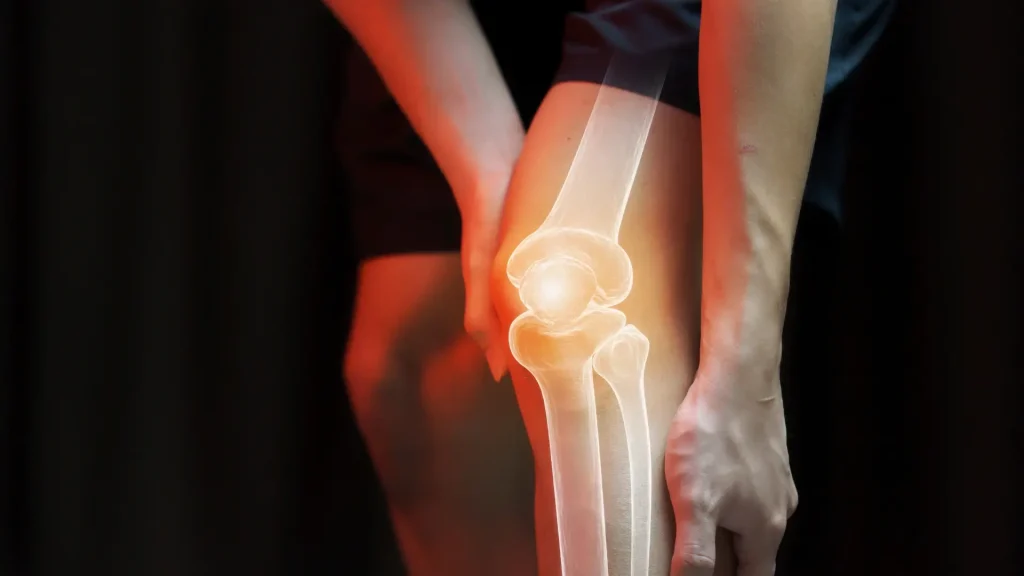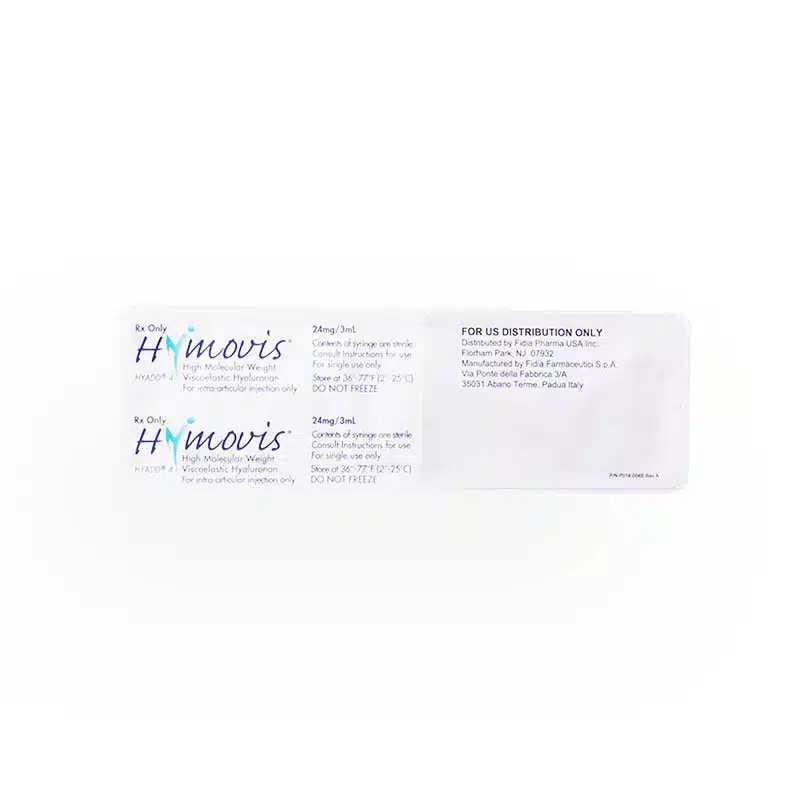Did you know that knee osteoarthritis is one of the leading causes of disability in the United States? This progressive joint disease causes pain, stiffness, and discomfort, significantly affecting quality of life. Among the available treatments, hyaluronic acid injections, also known as viscosupplementation, have emerged as a popular non-surgical option.
Hyaluronic acid injections, such as Hymovis and Synvisc, offer relief by reducing pain, swelling, and stiffness in knee osteoarthritis (OA) patients. While there is no definitive cure for knee OA, these minimally invasive treatments effectively manage symptoms and improve mobility.
In this article, we will compare Hymovis vs Synvisc, focusing on their formulations, mechanisms of action, treatment protocols, and effectiveness based on clinical data.
Key Takeaways
- The injected formulation of viscosupplements improves the quality of the HA in synovial fluid, leading to lubrication and shock absorption.
- Hymovis injections contain high-molecular-weight viscoelastic hyaluronan of HYADD®4, while Synvisc offers an elastoviscous high-molecular-weight fluid, utilizing hylan A and hylan B polymers.
- When administered appropriately, these injectables supplement the natural synovial fluid and restore its viscoelastic properties, providing symptomatic relief.
- The US Food and Drug Administration has approved Hymovis and Synvisc as treatments for knee osteoarthritis in individuals who have not responded to simple analgesics and conservative therapies.
- Adhering to the standard regimen of Hymovis and Synvisc can lead to optimal treatment outcomes.
About: Medica Depot is your trusted all-in-one supplier, offering a range of high-quality medical injectables and supplies. Order Hymovis online at Medica Depot today! Whether for health professionals, plastic surgeons, dermatologists, licensed estheticians, or other specialists, we can offer genuine, brand-name products you may need. With Medica Depot, we prioritize serving you better to improve the patient’s quality of life.
Understanding Viscosupplements

Individuals with knee osteoarthritis (OA) who find little relief from first-line therapies often turn to viscosupplements as an alternative treatment. These injectable solutions contain hyaluronic acid (HA), a substance naturally present in the joint’s synovial fluid. Viscosupplements minimize pain, improve joint function, and provide symptomatic relief for patients with knee OA.
Viscosupplements work by restoring cushioning and lubrication in the affected joints. The injected hyaluronic acid improves the quality of the synovial fluid, enhancing its ability to reduce pain, swelling, and inflammation. This leads to better shock absorption and smoother, pain-free movement, helping individuals regain mobility and comfort in their daily lives.
Hymovis and Synvisc

When comparing Hymovis vs Synvisc, it’s essential to understand their differences in composition. Hymovis contains high-molecular-weight viscoelastic hyaluronan and utilizes HYADD®4, a unique hyaluronic acid derivative in hydrogel form derived from bacterial fermentation. Notably, it does not undergo chemical crosslinking.
On the other hand, Synvisc is composed of Hylan A and B polymers, which are derived from chicken combs. These polymers form Hylan G-F 20, an elastoviscous fluid that is chemically crosslinked to enhance its effectiveness.
How They Work in the Body
Despite differences in composition, both Hymovis and Synvisc work similarly in the body. These viscosupplements are injected into the affected joint to supplement natural synovial fluid, restoring its viscoelastic properties. By improving lubrication and shock absorption, both treatments help reduce joint pain, improve mobility, and enhance the quality of life for individuals with knee osteoarthritis.
Clinical Effectiveness
The Hymovis prescribing information showed that the two-injection regimen offers better pain relief results than phosphate-buffered saline, with fewer adverse events and no patient discontinuing the treatment. Furthermore, another study demonstrated that Hymovis is non-inferior to Hyalgan’s five-injection regimen.
In a clinical trial conducted by Wobig et al., patients treated with Synvisc experienced an average 48.8% reduction in weight-bearing pain from baseline after six months. In comparison, those treated with saline saw a 25% reduction. Additionally, patients reported no local adverse reactions following their Synvisc knee injections.
It’s worth noting that the US Food and Drug Administration has approved Hymovis and Synvisc as treatments for knee osteoarthritis in individuals who have not responded to simple analgesics and conservative therapies. This Synvisc and Hymovis FDA approval highlights the rigorous trials and studies that these injectables went through, proving their safety and efficacy.
Treatment Protocols

Understanding the treatment protocols when comparing Hymovis vs Synvisc can help patients decide which treatment best suits their time and cost considerations. Proper injection administration for knee osteoarthritis (OA) can relieve pain and improve joint function.
- Administration of Hymovis: Medical professionals must administer Hymovis via intra-articular injection into the affected knee joint. The treatment boasts a two-injection regimen with a one-week interval.
- Administration of Synvisc: Like Hymovis and other viscosupplement, Synvisc requires intra-articular injection into the affected joint. According to Synvisc FAQs, a typical treatment protocol involves three doctor visits, spaced one week apart.
Adhering to these standard regimens of Hymovis and Synvisc can lead to optimal outcomes. Medical professionals should align these protocols to individual patient needs, considering factors such as the severity of the knee OA condition and the patient’s response to previous treatments. Appropriate administration and post-treatment can avoid potential Synvisc and Hymovis side effects that may lead to more complications.
Conclusion
Viscosupplements like Hymovis and Synvisc offer important symptomatic relief for individuals with knee osteoarthritis (OA). Understanding the differences in their composition and clinical effectiveness is crucial for both healthcare professionals and patients. The unique high-molecular-weight hyaluronan in Hymovis and the elastoviscous fluid in Synvisc reflect distinct formulations that may impact their suitability for different patient needs.
The FDA approval of both treatments underscores their safety and efficacy, particularly for those who have not responded to conservative therapies. Clinical data supports the benefits of these viscosupplements, providing hope for individuals seeking non-surgical solutions to manage knee OA effectively.
FAQs
1. What are viscosupplements?
Viscosupplements are injectable treatments containing hyaluronic acid (HA), which naturally occurs in the joint’s synovial fluid. They provide symptomatic relief in patients with knee osteoarthritis.
2. How do Hymovis and Synvisc differ from each other?
Hymovis injections contain high-molecular-weight viscoelastic hyaluronan of HYADD®4, while Synvisc offers an elastoviscous high-molecular-weight fluid, utilizing hylan A and hylan B polymers. They differ in their compositions and sources.
3. Are Hymovis and Synvisc FDA-approved treatments for osteoarthritis of the knee?
Yes, the US Food and Drug Administration has approved Hymovis and Synvisc as treatments for knee osteoarthritis in individuals who have not responded to simple analgesics and conservative therapies.
References
- Viscosupplementation Treatment for Knee Arthritis – OrthoInfo – AAOS. (2015). Aaos.org. https://orthoinfo.aaos.org/en/treatment/viscosupplementation-treatment-for-knee-arthritis/
- Osteoarthritis Clinical Trials & Studies | Synvisc‐One® (Hylan G‐F 20) | For HCPs. (n.d.). Www.synvisconehcp.com. Retrieved September 24, 2024, from https://www.synvisconehcp.com/synvisc-studies










